MOONSHOTS '24 gets off to a flying start with a well-attended ideas festival
At the end of last year, astronaut André Kuipers challenged students from vocational (mbo), higher (hbo) and university (wo) level to participate in MOONSHOTS '24. Friday was the kick-off of this search for brilliant, groundbreaking ideas – moonshots – that will change the world. Two hundred students and sixty space experts came to ESTEC in Noordwijk for a day full of wonder and inspiration.
There is a festival atmosphere in the Erasmus building of ESTEC in Noordwijk. Only there i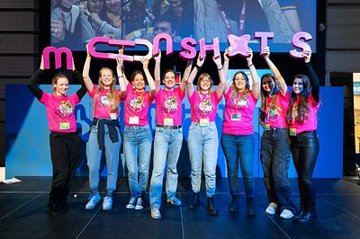 s no music on the program, but science and technology. Young people stand in groups around blue, yellow and green tables. Students of astronomy, physics, biochemical sciences, but also of electrical engineering, modern art and Celtic languages. They have markers, post-its, everything you need for a creative process. In the middle of the table is a bright pink telephone.
s no music on the program, but science and technology. Young people stand in groups around blue, yellow and green tables. Students of astronomy, physics, biochemical sciences, but also of electrical engineering, modern art and Celtic languages. They have markers, post-its, everything you need for a creative process. In the middle of the table is a bright pink telephone.
Table 48. The phone rings. It is Mission Control that provides the teams with valuable information and assignments. “Stay at your base camp,” says a voice on the other end of the line. 'You have an important appointment.' A little later, three students are, visibly tense, talking to André Kuipers about their rather 'crazy' idea. Kuipers has to control his scientist instinct – 'isn't that against the laws of nature?' – and takes on the role of coach. “What's really crazy?” he wonders out loud. “A hundred and fifty years ago you would have been called crazy if you said that people would ever fly through the air.”
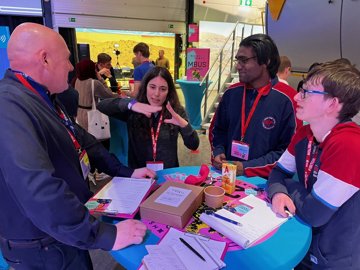
André Kuipers coacht Moonshots-students (image: Sander Koenen)
History of the future
MOONSHOTS '24 is organized on the initiative of the NSO, funded by the Ministry of Education, Culture and Science, and in collaboration with the Association of Space Explorers, the 'club of astronauts' of which André Kuipers is also a member. This fall, the ASE will come to the Netherlands for its annual Planetary Congress. Then the best MOONSHOT teams will present their idea on a large stage to more than a hundred astronauts. So they have eight months to develop their idea. There is no time to lose, as is evident from the energy in the Erasmus building.
Experts give lectures in small rooms. About robotics on Mars, the history of the future and groundbreaking space innovation that was once considered impossible. ESA astronaut Andreas Mogensen offers inspiration from space, with a video message from the ISS. And on podiums at the edge of the room, experts discuss with enthusiasm. Students can follow it from their own table with green or blue headphones, while their fellow students continue to talk about the possibilities and impossibilities of their idea.
Students who want to get their feet on the ground again can take a look at the Makers Market in the hall. Here, Makerspace from Delft demonstrates how an idea becomes reality. From a 3D scanner built from waste to solar panels for small satellites that can rotate 360 degrees, a laser show made from old hard drives and a second-hand 3D printer that engraves eggs.
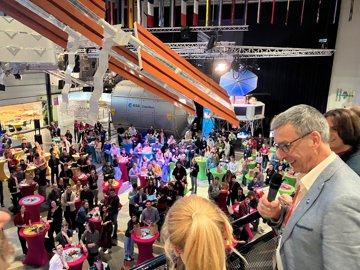
Deputy director NSO Joost Carpay: 'Don't be afraid to make mistakes'
Imagination drives progress
Errors do not exist in the first phase of MOONHOTS. There are only ideas. Daniel Crovato (TU/e) and Coen Ris (HvA) want to use neutrinos to communicate in space. Because with neutrinos you could even reach astronauts on the far side of Mars. Expert Ivo van Vulpen, particle physicist at NIKHEF, sees a thousand problems. But he also sees ambition. And wasn't ambition what made the CERN particle accelerator in Switzerland possible?
The sixty experts from space, science and technology are clearly enjoying the uninhibited festival of ideas. They hear one moonshot after another, the name of which refers to John F. Kennedy's dream to put men on the moon. “A moonshot is something that seems impossible, but which ultimately turns out to be possible,” says Kuipers. 'And young, enthusiastic students are uniquely capable of coming up with such ideas.'
Significantly improve heal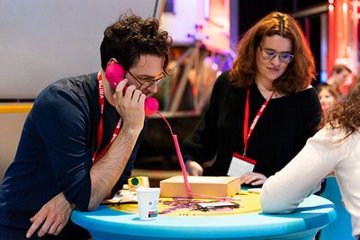 thcare with the help of robots, powered by Elon Musk's Neuralink technology. Making fuel from water ice on the moon. Building huge batteries in space to store energy from the sun. And then send that energy to Earth during harsh winters.
thcare with the help of robots, powered by Elon Musk's Neuralink technology. Making fuel from water ice on the moon. Building huge batteries in space to store energy from the sun. And then send that energy to Earth during harsh winters.
Torsten van Drogenbroek, Nil Meya I Mendoza and Ruben Bikker registered individually for MOONSHOTS. Now they are team 27 and they want to 'terraform' exoplanets. In other words: creating the ideal second earth if humans ever have to flee from the earth. They are not afraid to dream big. One of the speakers had called them to do so with a famous quote from Albert Einstein: 'Imagination is more important than knowledge. Knowledge is limited, whereas imagination embraces the entire world, stimulating progress, giving birth to evolution.”
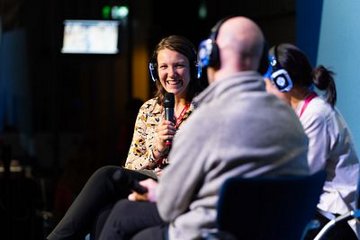
Pioneers in the Netherlands
Joost Carpay, deputy director of the NSO, is also present as an expert. He talks about the innovative power that our country has always had: 'A long time ago, in the eighties, there was a bunch of Dutch people with a crazy idea. They wanted to investigate the Earth's atmosphere with a spectrometer, from space! It led to a whole series of instruments. The latest in that series, SPEXone, was launched this week on board an American satellite.'
It is important to dream, Carpay wants to say: 'I find it inspiring to see you all together here, and I dream that you will continue the work of those Dutch space pioneers in the 1980s. Do what your heart tells you. And don't be afraid to make mistakes.'
When the teams go home after a long day - heads pounding from all the impressions and eager to get started - the Erasmus building slowly returns to its original state. Lucien Geelhoed, project leader of MOONSHOTS '24, looks back with satisfaction: 'Today the student teams met for the first time. From now on, their collaboration starts. Within the team or with other teams. Students from all directions, from all disciplines, with great ideas for the future.'